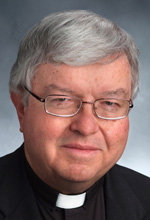Q. I recently attended the wedding of a young man and his bride who are both practicing Catholics. At the end of the ceremony, the congregation was confused when the priest (newly ordained) did not pronounce the couple as “man and wife” and introduced them as such to the attendees.
It was all very awkward, and no one seemed to know what to do. Finally, the organist began the recessional music and the bride and groom exited. When asked later why he did not introduce the couple, the priest said that it was not a part of the marriage rite of the church.
Weddings should be such joyous occasions, but this put a damper on it. I think that the priest’s rigid adherence to ritual could well have alienated people from the Catholic Church. What is your feeling? (Jefferson City, Mo.)
A. Sometimes at Protestant weddings — and often in television and movie weddings — a minister at the end of the ceremony pronounces and presents the couple as man and wife. That is not — and, to my knowledge, never has been — part of the Catholic marriage rite.
In fact, for a priest to use that declaration would reflect bad theology. In the Catholic view, marriage is unique among the sacraments in that, in marriage, the priest does not administer the sacrament. He is there simply as the witness.
The ministers of the sacrament of marriage are the couple, by virtue of their exchange of vows. The priest then blesses that commitment and prays for the newly married couple. So a Catholic priest would have no right “pronouncing” the couple as man and wife. They have done that already, on their own.
What surprises me, honestly, is not so much your question but your concluding observations — that the priest’s failure to “pronounce” dampened people’s joy and may have alienated some of them from the church. Over 46 years, I’ve probably done 600 or 700 weddings and have never been told that.
Q. My wife is relatively new to the Catholic Church and absolutely abhors the exchanging of the sign of peace. I remember when this was not a part of the Mass. It seems to have been an accretion that crept into the liturgy during the “feel-good” 1970s, and I agree with my wife that it is quite unnecessary.
My wife is on the shy side and prefers not to have to shake hands with the person who happens to be next to her in the pew. At most, she would nod but feels that this would be rude. Are there any options? (If you ran a petition drive to eliminate the sign of peace, I’ll bet that it would be greeted with 95 percent approval from Catholics.) (Louisville, Ky.)
A. Far from being a new invention of the 1970s, the restoration of the sign of peace was actually a return to a practice common in the earliest days of the church. In those times, Christians, in a reminder of the charity that linked the eucharistic community, exchanged a greeting at the offertory — that timing chosen from the suggestion of Jesus (Mt. 5:23-24) that one reconcile with others before presenting gifts at the altar.
By the late fourth century, the exchange of peace had been placed instead right after the Our Father, since Christians were committed to live in harmony with those with whom they were about to share the Eucharist. The greeting of peace faded gradually into disuse over the centuries and was restored to the Mass during the liturgical reforms following the Second Vatican Council.
Technically, the sign of peace is optional. The General Instruction of the Roman Missal prescribes in No. 154 that it be shared “when appropriate.” But other sections of the general instruction (in No. 82 and No. 239) imply that it is customarily used. (During a flu epidemic, for example, the exchange of peace could reasonably be suspended.)
The greeting ought to be exchanged in a quiet and dignified manner, and Pope Benedict XVI reminded Catholics in 2006 that restraint was needed lest the gesture distract from the reverence appropriate to the reception of holy Communion. (Marathons during which congregants roam the church widely in search of hugs would seem to run counter to that caution.)
The particular type of greeting is not prescribed worldwide but left to be tailored by national conferences of bishops to the customs and culture of the place. In the U.S., a handshake is common, while an embrace or kiss is often used for family or close friends. Some simply nod or wave, which is surely acceptable. (Eye contact, though, would seem to be at least a minimum requirement.)
***
Questions may be sent to Father Kenneth Doyle at askfatherdoyle@gmail.com and 40 Hopewell St., Albany, NY 12208.
PREVIOUS: This Advent in the cold night, look not east, but up
NEXT: Pope Benedict XVI’s prayer intentions for January




Share this story